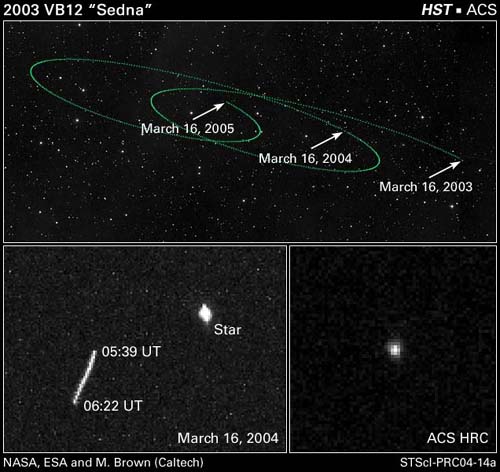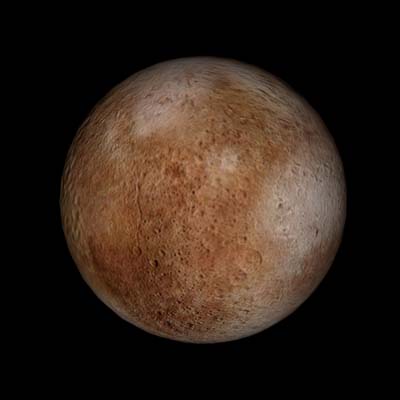90377 Sedna
The most distant large object yet found orbiting the Sun; its classification remains uncertain – some researchers claim it is a detached Kuiper Belt object, while others suspect it might belong to the Oort Cloud. Sedna, named after the Inuit goddess of the ocean, is currently three times further away than Pluto, the average distance of which from the Sun is 5.9 billion km (3.6 billion miles). At its most distant, Sedna is almost 150 billion km (93 billion miles) from the Sun, or 990 times Earth's solar distance. It has an obital period, or year, of some 10,500 years. Its surface temperature is believed to be about -240°C (-400°F).
Sedna, originally designated 2003 VB12, was first seen on Nov. 14, 2003 with the 48-inch Samuel Oschin Telescope at California's Mount Palomar Observatory. Astronomers from the California Institute of Technology, Yale University, and the Gemini Observatory were involved in the discovery. Observations show it measures less than 1,700 km (about 1,000 miles) in diameter, which is smaller than Pluto. Sedna has a high albedo and very red – the reddest large object in the Solar System after Mars. Its size suggests it should not be classified as a true planet, although there is disagreement among astronomers on this point and there are no hard and fast rules about what counts as a planet, planetoid, or minor planet. Sedna rotates more slowly on its axis than expected, suggesting it may have a satellite orbiting it.
Sedna is probably half-rock and half-ice but further observations will be needed to confirm this. Although Sedna could be a so-called Kuiper belt object (KBO), its discoverers have cast doubt on this. The object's elliptical orbit is unlike anything previously seen by astronomers. It could be the first detection of the long-hypothesized Oort cloud, a faraway repository of small icy bodies that supplies some of the comets that streak by Earth. This cloud is believed to surround the Sun and extend outward at least a third of the way to the nearest star. But Sedna is 10 times closer than the predicted distance of the Oort cloud. Sedna might belong to an inner Oort cloud that could have formed by gravity from a rogue star near the Sun in the Solar System's early days. Early in the history of the Solar System there must have been many more stars very close to the Sun than there are now stars that were born in the same cluster as the Sun.
It was officially designated in September 2004 as minor planet 90377 Sedna.

Sedna as seen by Hubble Space Telescope.
| Sedna facts* | |
| Discoverer | Michael E. Brown, Chad Trujillo, David Rabinowitz |
| Discovery date | November 14, 2003 |
| Diameter | 1,060 km |
| Axial period | 10 hr |
| Eccentricity | 0.841 |
| Orbital Inclination | 11.929° |
| Semimajor axis | 479.65 UA |
| Perihelion | 76.155 UA |
| Aphelion | 883 UA |
| Orbital period | 10,505 years |
| Albedo | 0.32 |
| Absolute magnitude | 1.83 |
* Data from Wikipedia 2020

